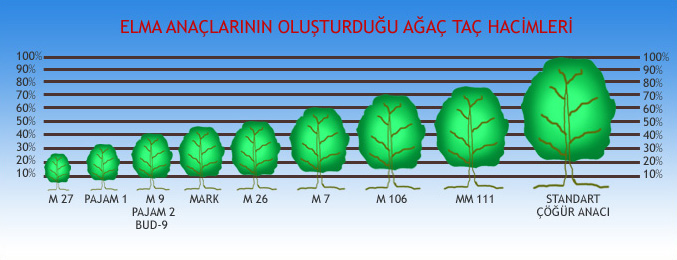M9 ROOTSTOCK
- This is the full dwarf apple clone rootstock developed in East Malling Institute in the UK. This is the most commonly preferred apple clone rootstock known for early yield and increasing the size of the fruit.
- Despite being strong against winter conditions and heavy textured soils, it is sensitive to high ground waters and soils with standing water.
- 25-30% of the tree formed by a standard generative rootstock is the volume of tree.
- It ripens the fruit one week earlier compared to the generative rootstock.
- Having similar characteristics with the M9 rootstock developed in France, Pajam 1 rootstock grows weaker than the M9 while Pajam 2 grows 10% stronger than the M9; rootstocks like Mark 9, NAK-B 337, EMLA- 9, Budavgosky 9, and M9 T 339 have similar characteristic with rootstock M9.
- An apple tree forms a 2.5m-3m high crown on this rootstock in full yield.
- Since the root system is very sensitive and fragile, it absolutely needs a supporting system. With concrete supports in 10-15m gaps or impregnated tree should be 50-60 cm deep under the soil and 2.5-3m high over the soil.
- A support system is created for the trees with the first wire at 50 cm high above the ground and 4 or 5 wires at each 50 cm then.
- Plant spacing on this rootstock can be 4x1 m or 4x1.2 m, while the gap on a line can be reduced 60 cm and the gap between the lines can be reduced to 3.5 m if the soil isn't very yielding.
- 120 to 400 nursery stocks are required for one decare in a M) rootstock farm and drip irrigation system must be available.
- On this rootstock, it is possible to obtain 500-1500 kg product in 2-3 years, 5-6 tones in 5-6 years and 10-12 tones in 7-8 years which are the most abundant years of trees.
- Resistant to phytopthora and sensitive to fire blight bacterial disease.
- Since fire blight is observed on species such as Grany Smith and Golden Delicious grafted on to the M9 rootstock, it is useful to use a shadowing material particularly in regions with intense sunshine.
- Scarlet Spur. Redcief, Spur Golden apple species shouldn’t be grafted onto this rootstock.

MM 106 ROOTSTOCK
- It is a semi-dwarf apple clone rootstock. It is similarly growing as the M7 rootstock and apple grows 50-60% of a standard generative rootstock.
- Sensitive to phyttopthora (root rot), resistant to woolly aphid and fire blight.
- It should never be preferred in heavy textured soils with weak drainage.
- Early yielding for the species on it.
- A good rootstock for those with spur characteristics (weakly growing species).
- The species on it ripens a few days later compared to rootstock M9.
- Since the root system develops better than rootstock M9, it doesn't need supporting systems.
- In farms planted with this rootstock, the gaps on a line are 2-2.5 m while gap between the lines is 3.5-4m and number of nursery stock change between 85 and 120 in a decare.
- With the spur species (semi-dwarf) on this rootstock, denser farms can be planted.
- No too much stool.

MM 111 ROOTSTOCK
- It is one of the strongly growing rootstocks and forms a volume about 75% of the generative rootstock.
- Resistant to woolly aphid and ideal for the limited irrigation conditions and loamy sand soils.
- Harmony with the new species such as Fuji, Gala, Pink Lady is perfect.
- No supporting system is required due to a strong root system.
- Spur species on this rootstock can be planted in 2.5-3m on a line and the gap between the lines is 4m, while the standard species can be planted in 3-3.5 m on a line and gap between lines is 5m. - Recently, in some countries rootstock M9 is intergrafted on the rootstock MM 111, thereby trees more dwarf than the MM111 and with a better root system are formed while the superior characteristics of both rootstocks are combined.

M 26 ROOTSTOCK
- Early yielding for the fruits on it.
- It forms trees about 35% of the standard generative rootstock.
- Semi-dwarf spur species can be grafted onto this rootstock.
- Recommended for the good drained soils and resistant to the cold weathers.
- Require support system.

M 7 ROOTSTOCK
- One of the most common rootstock in USA.
- Forms trees with same growing ability as MM106.
- Resistant to Agrebakterium tumefaciens (root cancer) bacterial disease.

M 27 ROOTSTOCK
- This is the most dwarf apple rootstock and no commercial garden is recommended with the species grafted onto this rootstock.
- It is more suitable to utilize it as a rootstock in pots and home yards.

Characteristics of Some Apple Clone Rootstocks
|
ROOTSTOCK
|
TREE GROWING ABILITY |
LIME RESISTANCE |
UNDERGROUND WATER RESISTANCE |
RESISTANCE TO ARIDITY
|
STOCK PLANTING GAPS
|
|
M9
|
3,5 m x 1,0 m Spur Species 3,5 m x 2,0 m Standart Species |
||||
|
EM 26
|
3,5 m x 1,2 m Spur Species 3,5 m x 2,0 m Standart Species |
||||
|
MM106
|
3,5 m x 1,5 m Spur Species 3,8 m x 2,2 m Standart Species |
||||
|
M7
|
4,0 m x 2,0 m Spur Species 4,0 m x 3,5 m Standart Species |
||||
|
MM111
|
4,0 m x 2,0 m Spur Species 4,0 m x 3,5 m Standart Species |

